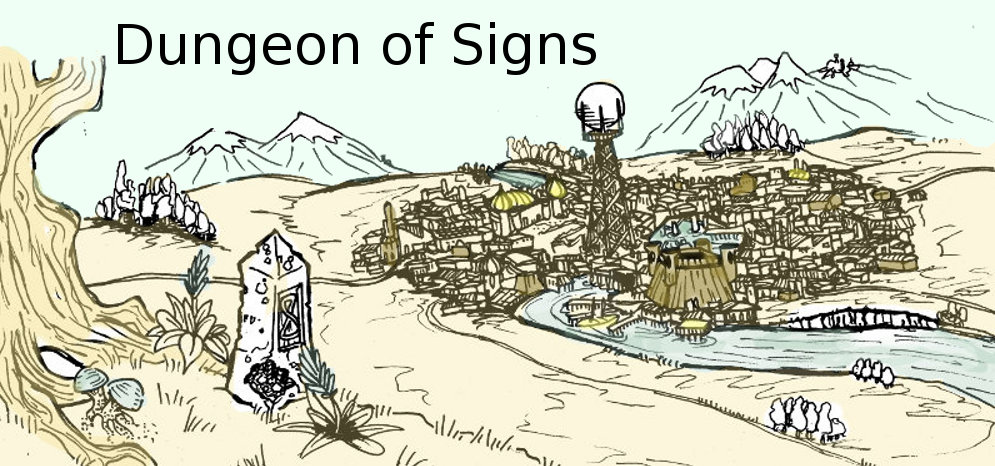EXPANDING THE OD&D/LOTFP SKILL SYSTEM
 Below is a list of skills that I intend to use for my
HMS Apollyon games, it includes variants (Legerdemain, Stealth, Acrobatics,
Tinker and Search) of the standard ones found (often limited to thieves) in
most D&D/D20 systems. Specifically I’ve modeled these on the
LOTFP system of “X
in 6” chance of success. I
personally like this far better than the percentile system simply as it feels
simpler and can shift more readily with level gain, especially in a system
where high level play isn’t
common, or level is capped at 10th (As it is in my own Apollyon
Game, and as it seems to be by the nature of LOTFP play). These skills do a couple things that I
like. First they offer variability to
the thief class, and other classes as well – a
ranger need not be a separate class, but perhaps just a fighter or specialist
with a focus on Animal Handling and Survivial.
Second they allow me to provide alternatives to certain first level
spells while keeping those spells useful.
Last they provide some mechanical tests for certain types of odd
activities or provide an element of random failure/success for other popular
adventurer activities (such as collecting monster poison).
Below is a list of skills that I intend to use for my
HMS Apollyon games, it includes variants (Legerdemain, Stealth, Acrobatics,
Tinker and Search) of the standard ones found (often limited to thieves) in
most D&D/D20 systems. Specifically I’ve modeled these on the
LOTFP system of “X
in 6” chance of success. I
personally like this far better than the percentile system simply as it feels
simpler and can shift more readily with level gain, especially in a system
where high level play isn’t
common, or level is capped at 10th (As it is in my own Apollyon
Game, and as it seems to be by the nature of LOTFP play). These skills do a couple things that I
like. First they offer variability to
the thief class, and other classes as well – a
ranger need not be a separate class, but perhaps just a fighter or specialist
with a focus on Animal Handling and Survivial.
Second they allow me to provide alternatives to certain first level
spells while keeping those spells useful.
Last they provide some mechanical tests for certain types of odd
activities or provide an element of random failure/success for other popular
adventurer activities (such as collecting monster poison).
There is a debate to be had regarding the use of
skills, including all the classic “Thieves’ Skills” because it’s often opined that rolling
dice to solve a problem rather than allowing the players to use their
creativity to figure out the puzzle involved diminishes one of the best aspects
of tabletop gaming. However, I think
these skill are mostly limited to areas where some mechanical component is
necessary. There should be some
mechanical component to certain activities that can’t be part of player skill,
but are obvious elements of character knowledge. Specifically things that
specialists (or other subclasses) know that cannot be readily known by players
and which have a mechanical import. The
most clear example of this sort of skill is something like “Arcana” or “Tinker” as no game I’ve been in has available
locks to pick or secret languages to focus hermeneutic knowledge on. Moreover, focusing on these tasks for too
long detracts from the play of other players who aren’t figuring out the lock
puzzle or deciphering the secret inscription.
On the other end is something like the “Search”
which really should be easy to model with player knowledge (I pull on the
candle holder, I dig through the refuse pile etc.) but demands a great deal of
knowledge by the GM regarding things like secret door mechanisms and what sort
of dungeon dressing is scattered about (both to conceal valuables and to provide
pointless things to search).
A GM can’t
always have these things, but a good module should make efforts at description
with this in mind. Rather than saying “secret door in North wall” something like “twisting a torch holder
(one of several) on the North wall clockwise will cause a latch to snap open
and reveal the secret door on the North Wall”. Yet this isn’t always possible, and sometimes describing
the wide variety of cruff on the floor of a goblin lair that the party can dig
through is not a good use of game time.
In these cases a skill is helpful.
Skills also have an advantage of being clear about time and risk, with
each skill roll taking one turn (10 minutes roughly but who knows in a game
using an overloaded encounter die - as opposed to the Gygaxian strict
timekeeping), a roll on a random encounter/exploration die – and a clear risk reward
calculation for the players.
It is for this reason, the encounter roll, that unless there are compelling
circumstances I don’t
bother with catastrophic failures for character failure with skills. It’s
usually just wasted time, though in some circumstances (trying to stealth past
alert guards, trying to run up a wall Kung Fu movie style in combat, trying to
disarm a ticking bomb or doing emergency surgery on a dying comrade) there are
obvious consequences.
The ultimate point is that I like these skills and find
they add aspects to the game, specifically a deeper, faction based exploration
game, especially in that they both encourage players to use their skills – a character with a
survival skill will try to identify local flora, because they can – and allow the creation of
a wider variety of character types.
Specialists need not simply be magsmen, sneak thieves or an assassin, but
can be tinkers, scholars, charlatans and doctors. While the descriptions below are written with
my own Apollyon Setting in mind I think they can be generally applicable to
most exploration based settings.





